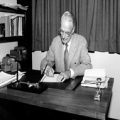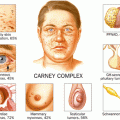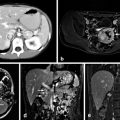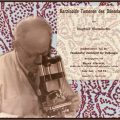Emil Theodor Kocher (From National Institutes of Health, unknown photographer)
Emil Theodor Kocher was an outstanding personality, self-critical, systematic, modest, laborious and driven by a tremendous thrive for innovation. His capacity to link a clinical observation to its hitherto mostly unknown physiological basis was his fundament to revolutionize the surgical field and influence innumerable young surgeons across the world. Albeit described as a reserved personality, he entertained long lasting friendship with most great surgeons at his time including William Halsted, Harvey Cushing, and Theodor Billroth. Those and many more connections together with his scientific and surgical achievements helped to leverage the Inselspital—founded in 1354 and later transformed to the University Clinic of Bern —to worldwide fame at the end of the 19th century. It goes without saying that the receipt of the Nobel Prize was the culmination of his success awarding his greatest accomplishment, mastering thyroid surgery and more importantly understanding its physiology. When he died the entire Swiss government attended his funeral and all children of the city of Bern, the capital of Switzerland, had a day off school. It is impressive to observe how lasting Kocher’s heritage is in “his” Inselspital and in our collective memories. Prof. D. Candinas
Emil Theodor Kocher was born on August 25, 1841, in the capital of Switzerland, Bern. As the son of the chief engineer of the canton of Bern, Jakob Alexander Kocher, the young Kocher grew up in a peaceful, culturally sophisticated, and religious atmosphere. He was characterized as a quiet, unassuming, but sometimes mischievous boy. After finishing secondary school, he trained without interruption at the University of Bern, from which he graduated and obtained his doctorate in 1865 [1]. He started his surgical career after medical school in Bern, but his talent and purposefulness took him to advanced studies at academic centers such as Zurich, Berlin, London, Paris, and Vienna. There, he learned under famous teachers, including Hermann Askan Demme (1802–1867), Georg Albert Lücke (1829–1894), Theodor Billroth (1829–1894), and Bernhard von Langenbeck (1810–1887). As associate professor, he returned to Bern, where he worked as a surgical assistant under Professor Georg Lücke. It was no surprise that in 1872 he was promoted to full professor of surgery; at this time, he also became director of the University Surgical Clinic in Bern as the position became vacant. He was only 31 years old when he was appointed to this job. He held the position until his death on July 27, 1917, 45 years later; this was an unprecedented feat. Even for those early years, selection as chair of a surgical department at age 31 was an outstanding honor. Whenever Kocher was invited to consider other lofty academic surgery positions around Europe, including Prague, Vienna, and Berlin, he deferred [2]. Throughout his career, he remained committed to his beloved hometown of Bern, where he found ideal conditions for his work. He was a humble man and reserved by nature; however, by report, he was very warm with patients, who uniformly loved him [3].
It was still very early in his medical and surgical career when Kocher described a new method for reducing shoulder dislocations and first received the attention of Theodor Billroth, who would become one of his critical mentors. Kocher intensively studied the pathologic anatomy of the shoulder and was then able to demonstrate his newly developed reduction technique on a patient with an old subcoracoid dislocation. During a conference, all attempts to reduce the patient’s shoulder by multiple physicians, including Billroth, failed. Kocher then volunteered to give his newly developed technique a try in front of multiple visiting physicians—and it worked on the first attempt! He called his technique for reducing shoulder dislocations the “Kocher method” [4]. His method was soon widely accepted, as it was shown to be simple, safe, and applicable for chronic and acute dislocations.
Kocher started his surgical career shortly after the appreciation of antiseptic treatment of wounds. He was heavily influenced by Sir Joseph Lister (1827–1912), a pioneer of antiseptic surgery . Kocher steadily supported the transition to using sterile technique, as he understood its immense importance and benefit for most patients. He was also one of the first surgeons who worked in a completely aseptic fashion. He benefited from close collaboration with Ernst Tavel (1858–1912) from the University of Bern, who was famous for his bacteriological studies [1]. They summarized their findings in the second edition of “Vorlesungen über chirurgische Infektionskrankheiten” (lectures on surgical infectious diseases), which was published in 1895 [5]. The University Clinic in Bern, Inselspital , remained for many years an international centerpiece among physicians who favored the antiseptic approach.
Aside from extensive work on antiseptic treatment, Kocher started to publish widely on a diverse set of topics in general surgery. One early publication included experiments about hemostasis (by torsion of the arteries); this pleased Billroth, especially, and it was published in Langenbecks Archive, Vol II [1]. Kocher also performed studies on gunshot wounds, as he had to give courses to military doctors. He worked on acute osteomyelitis (1878) and the theory of strangulated hernias (1877). He developed a new theory of hernia strangulation that was called the “dilation theory”; this received attention in the field of ileus research. He published regarding a new technique for gastric resection, describing pylorectomy with subsequent gastroduodenostomy. In addition, Kocher advanced the surgical procedure initiated by Kraske, where part of the coccyx was removed during rectal surgery to facilitate additional removal of a portion of the sacrum (1874), and he described gallstone excision from the lowest portion of the bile duct. One of the most important procedures he described in detail was the mobilization of the duodenum and pancreatic head from its posterior attachments and neighboring organs, including the inferior vena cava. This helped to advance many surgical procedures, including surgery on the duodenum, extrahepatic bile duct, pancreas, and stomach. This crucial step of early mobilization is employed as part of many larger upper gastrointestinal (GI) operations, and it is named the Kocher maneuver, or Kocher mobilization.
The list of his contributions seems to be endless, as he also published on simplified cholecystectomy procedures, ileus treatment, vertebral column fractures, traumatic epilepsy, brain damage, and trepanation. Most surgical specialties have benefited from the findings, inventions, and descriptions of Kocher. He also was respected by his peers because he reported his own patient outcomes regularly. His transparency regarding his own outcomes was novel. Importantly, Kocher for the first time demonstrated an association between increased (surgeon) volume and improved (patient) outcomes. Indeed, Kocher’s outcomes following thyroidectomy improved dramatically over the course of his prolific career. Until his death at age 76 years, he was able to keep up with the same pace and rigor that he did when he started his surgical and scientific career.
Stay updated, free articles. Join our Telegram channel

Full access? Get Clinical Tree







